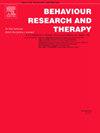The Leuven Exeter Dampening Scale (LEDS) to measure dampening appraisals towards positive affect: Psychometric evaluation and initial validation in a Dutch and English community sample
IF 4.5
2区 心理学
Q1 PSYCHOLOGY, CLINICAL
引用次数: 0
Abstract
Dampening – the tendency to downplay positive feelings – is linked to various psychopathologies, demonstrating transdiagnostic relevance. Most research to date has relied on the dampening subscale of the Responses to Positive Affect Scale (RPA-d; Feldman et al., 2008). However, concerns about its limited content validity, not reflecting clinical complexity, and potential cross-cultural universality issues prompted the development of the Leuven Exeter Dampening Scale (LEDS). Study 1 details scale development in Dutch-speaking undergraduates (N = 308); Studies 2 and 3 further validate it in a Dutch-speaking (N T1 = 214, N T2 = 148) and English-speaking UK (N T1 = 177, N T2 = 152, N T3 = 102) adult community sample. Across samples, the LEDS showed excellent internal consistency (αs > .90) and good test-retest reliability (ICCs = .77-.89). Confirmatory factor analyses supported a one-factor structure, demonstrating structural validity. LEDS scores positively correlated with RPA-d scores, indicating convergent validity. Multiple regressions showed the LEDS to significantly predict concurrent anhedonic/depressive symptoms, beyond age, gender, and negative rumination, supporting its concurrent predictive validity. Even with the RPA-d included as predictor, the LEDS accounted for unique variance in concurrent outcomes, showing incremental validity. Longitudinal analyses, covarying baseline symptoms, provided mixed evidence with predictive and incremental validity only verified in the UK sample. Crucially, the RPA-d never outperformed the LEDS, and mixed prospective findings align with prior inconsistent prospective relations between dampening and symptomatology. Findings support the LEDS as a valid alternative to the RPA-d, with a more comprehensive assessment of general dampening as key strength.
鲁汶埃克塞特抑制量表(LEDS)测量对积极影响的抑制评价:荷兰和英语社区样本的心理测量评估和初步验证。
压抑——淡化积极情绪的倾向——与各种精神病理有关,显示出跨诊断的相关性。迄今为止,大多数研究都依赖于积极情绪反应量表的抑制子量表(RPA-d; Feldman et al., 2008)。然而,考虑到其有限的内容有效性,不能反映临床复杂性,以及潜在的跨文化普遍性问题,促使了鲁汶埃克塞特阻尼量表(LEDS)的发展。研究1详细介绍了荷兰语本科生的量表发展情况(N = 308);研究2和研究3在荷兰语(NT1 = 214, NT2 = 148)和说英语的英国(NT1 = 177, NT2 = 152, NT3 = 102)成人社区样本中进一步验证了这一点。在不同的样品中,led显示出良好的内部一致性(αs > .90)和良好的测试-重测信度(ICCs = .77-.89)。验证性因子分析支持单因子结构,证明结构效度。LEDS得分与RPA-d得分正相关,表明趋同效度。多元回归结果显示,LEDS能显著预测并发性快感缺乏症/抑郁症状,超越年龄、性别和消极反刍,支持其并发性预测效度。即使包括RPA-d作为预测因子,led在并发结果中占唯一的方差,显示出增量的有效性。纵向分析,共变基线症状,提供了混合证据,预测和增量有效性仅在英国样本中得到验证。至关重要的是,RPA-d的表现从未超过LEDS,混合的前瞻性研究结果与先前不一致的抑制和症状之间的前瞻性关系一致。研究结果支持led作为RPA-d的有效替代品,更全面地评估了一般阻尼作为关键强度。
本文章由计算机程序翻译,如有差异,请以英文原文为准。
求助全文
约1分钟内获得全文
求助全文
来源期刊

Behaviour Research and Therapy
PSYCHOLOGY, CLINICAL-
CiteScore
7.50
自引率
7.30%
发文量
148
期刊介绍:
The major focus of Behaviour Research and Therapy is an experimental psychopathology approach to understanding emotional and behavioral disorders and their prevention and treatment, using cognitive, behavioral, and psychophysiological (including neural) methods and models. This includes laboratory-based experimental studies with healthy, at risk and subclinical individuals that inform clinical application as well as studies with clinically severe samples. The following types of submissions are encouraged: theoretical reviews of mechanisms that contribute to psychopathology and that offer new treatment targets; tests of novel, mechanistically focused psychological interventions, especially ones that include theory-driven or experimentally-derived predictors, moderators and mediators; and innovations in dissemination and implementation of evidence-based practices into clinical practice in psychology and associated fields, especially those that target underlying mechanisms or focus on novel approaches to treatment delivery. In addition to traditional psychological disorders, the scope of the journal includes behavioural medicine (e.g., chronic pain). The journal will not consider manuscripts dealing primarily with measurement, psychometric analyses, and personality assessment.
 求助内容:
求助内容: 应助结果提醒方式:
应助结果提醒方式:


